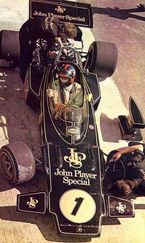.
Lotus Mark II
| place image here in 300 pixels | |
| Lotus Mark II | |
|---|---|
| Race Car | |
| Category | Classic Trials |
| Constructor | Lotus |
| Chassis | |
| Suspension (front) | |
| Suspension (rear) | |
| Engine | |
| Power | N/A hp @ N/A rpm N/A lb-ft. of torque @ N/A rpm |
| Transmission | |
| Fuel | |
| Tyres | |
| Notable entrants | |
| Notable drivers | |
| Debut | pending (if not yet introduced) |
| Races competed | |
| Race victories | |
| Constructors' Championships | |
| Drivers' Championships | |
| Pole positions | |
| Fastest laps | |
| Designer | Designer (lead designer if it was a team effort) |
The car that came to be known as the Lotus Mark II was created in 1949, while Colin Chapman was serving with the RAF. For his second car Chapman built on the knowledge gained from building and competing in the Lotus Mark I, so he again used the widely available and inexpensive Austin 7 chassis as a starting point. He boxed in the chassis rails and replaced the cross members with stronger tubular braces. He swapped the Austin engine for a Ford engine and transmission, first from a Ford 8, then from a Ford 10, but retained the Austin 7 rear axle. To be able to use a wider tire, Chapman adapted Ford pressed steel wheels. He modified the engine as far as the club rules would allow.
Chapman used this chassis and running gear to support a cigar-shaped body with a rounded nose. It has rudimentary cycle-type fenders. The result was a very competitive Trials car, but also suitable for circuit racing. Chapman used the car to compete in events sponsored by the 750 Motor Club. Although Chapman built the car to compete in English Trials events, he also entered the car in track events, such as Silverstone, where he won in his class. From that point forward, Chapman would concentrate on designing and constructing cars for race circuits instead of trials.
Ford Sidevalve Motor:
- Config: S4 SV
- Displacement: 1172 cc
- Bore/Stroke: 63.5 mm (2.5 in) x 92.456 mm (3.6 in)
Gallery
Complete Racing Results
(key) (results in bold indicate pole position)
| Year | Team | Engine | Tyres | Drivers | 1 | 2 | 3 | 4 | 5 | 6 | 7 | 8 | 9 | 10 | 11 | 12 | 13 | 14 | 15 | 16 | 17 | Points | WCC |
|---|---|---|---|---|---|---|---|---|---|---|---|---|---|---|---|---|---|---|---|---|---|---|---|
| YYYY | (Constructor) | (Engine) | (Tyre code) | ||||||||||||||||||||
Notes and references
See Also
References
- Tipler, John, Lotus and Caterham Seven: Racers for the Road The Crowood Press, 1995. pp. 14-16.
- Coulter, Jeremy, The Lotus & Caterham Seven: A Collector's Guide Motor Racing Publications, 1986. pp. 9-10.
- William Taylor, The Lotus Book: The Complete History of Lotus Cars Coterie Press, Limited.1998, pp. 14-15.
External links
| Wikimedia Commons has media related to: |
Please include any external sites that were used in collaborating this data, including manufacturer sites, in this section.
News and References
- Motorbase Accessed February 17, 2006
Enthusiast Sites and Discussion Forums

